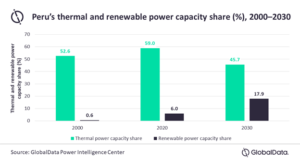
The Peruvian Government is planning to push renewable power growth, especially onshore wind power, as it seeks to reduce its dependence on hydropower and decrease its greenhouse gas (GHG) emissions. GlobalData expects Peru to reach a total renewable capacity of 3.91 gigawatts (GW) by 2030, of which onshore wind power will account for around 2 GW.

Power Analyst at GlobalData, Aditya Sharma, shared that hydropower generated the most electricity in Peru during 2020, accounting for 58.7 per cent of the total annual generation.
Sharma added that generation from thermal power was a distant second at 35 per cent, while renewable power contributed only a small share.
“However, this is set to change as renewable power capacity is set to increase from 0.94 GW to 3.91 GW during 2021–2030. Increased carbon emissions and high variable costs of thermal power generation have forced the Peruvian Government to look for other sources of power generation,” he said.
According to GlobalData’s report, Peru Power Market Outlook to 2030, Update 2021 – Market Trends, Regulations, and Competitive Landscape, cumulative thermal power capacity in Peru was 9.17 GW in 2020 and is set to see negligible growth during 2021–2030.
With no plans for nuclear power and high dependence on hydropower, the government is striving to achieve its energy transition with renewable power development.
Sharma noted that the geographical location of Peru is highly suitable for onshore wind development.
“The country’s coastline and mountain ranges offer high wind speeds of 7.5 m/s and more (at a height of 80 metres), making wind power financially viable and attractive for investments. The implementation of renewable auctions and favourable regulatory framework also supports the growth of onshore wind power,” he said.











